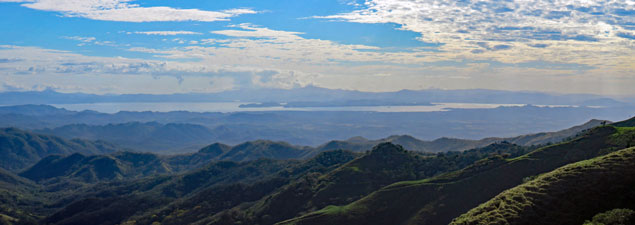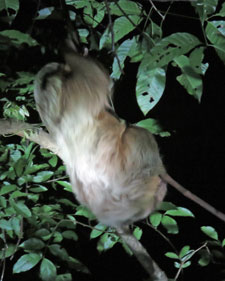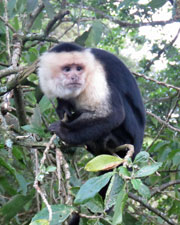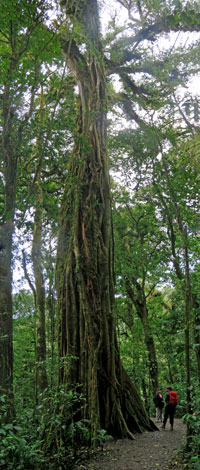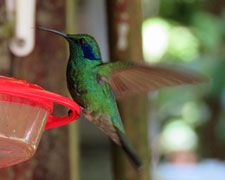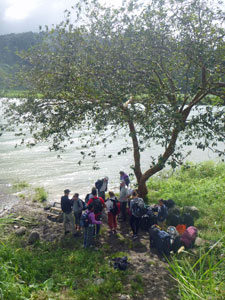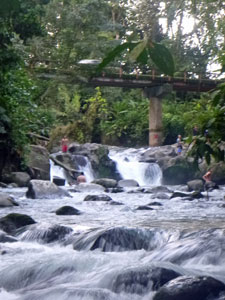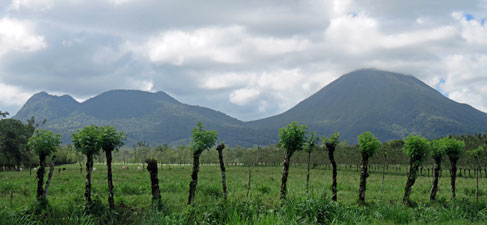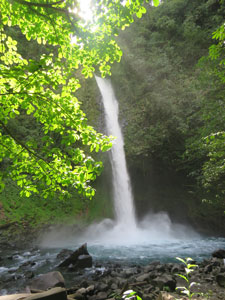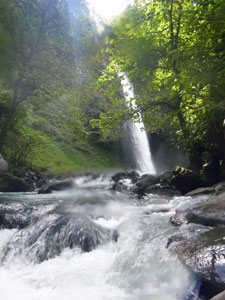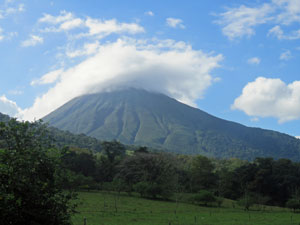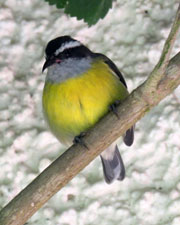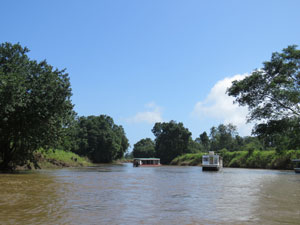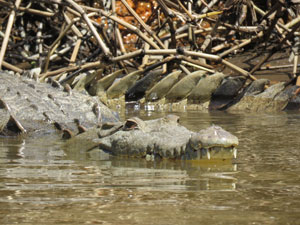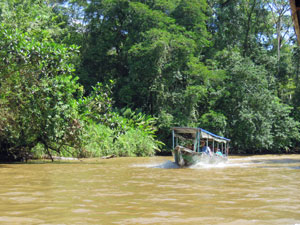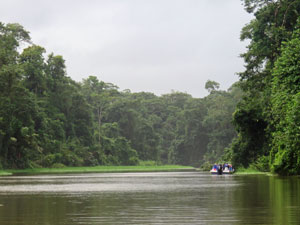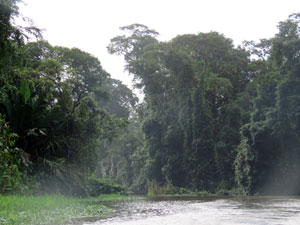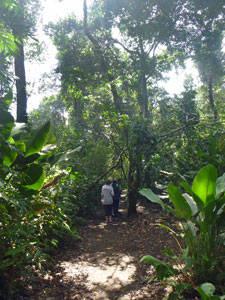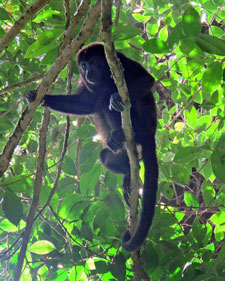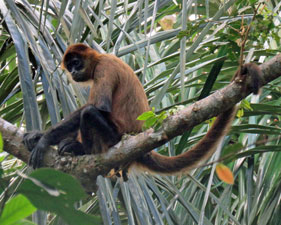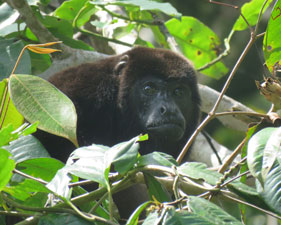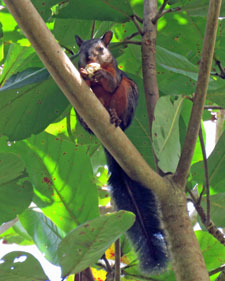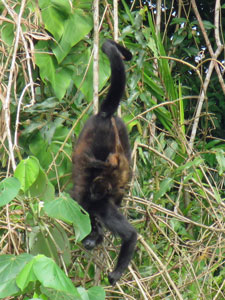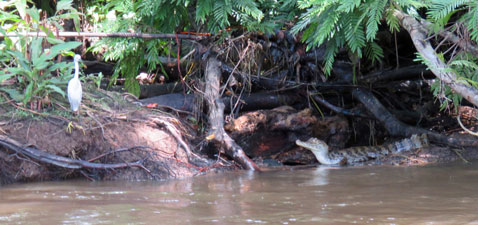| Costa Rica |
Monteverde |
Back at Rivas, we boarded the waiting mini-bus for the 45 minute drive to the chaotic border crossing between Nicaragua and Costa Rica, where kilometres-long queues of trucks waited on both sides to pass. Fortunately, people moved quicker and after an hour we were safely and legally in Costa Rica, on the next bus and heading south. It didn't take long to realise that Costa Rica is the most affluent Central American country – a noticeable decline in litter, improvement in housing and better roads greeted us, as we climbed up across the dry forested hills of north-eastern Costa Rica. Here the dogs no longer look underfed and you can drink the tap water. It shows what you can do if you don't have an army. |
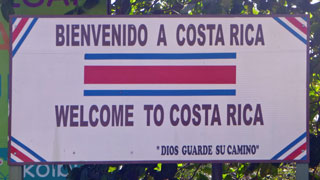 |
Soon we were driving down the 4-laned Pan-American Highway across the flat uplands, where contented cattle grazed. To the east a range of mountains lined the horizon and, after a couple of hours we turned towards them. It was only about 30km from the main road to our destination of Monteverde, but it took over an hour as our bus slowly cranked its way up the rough and winding gravel road to climb steeply up into the rugged hills. Every so often a broad panorama of the Gulf of Nicoya opened up to the west to show us just how high we had climbed.
|
At 1500m, Monteverde is a famous cloud forest region, where cloud banks up on the Caribbean side of the range, dropping over 2500mm of rain annually and frequently bathing the landscape in mist. These conditions have allowed the development of a dense and tall forest, which contrasts dramatically with the dry and open Pacific slopes of the range. |
|
||
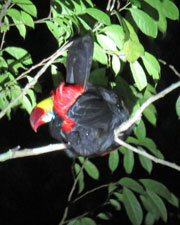 |
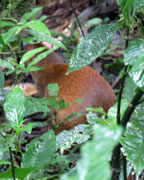 Let sleeping creatures lie |
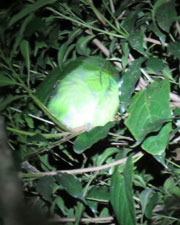 |
|
The wind was still blowing fiercely from the east when we arrived, but that did not deter us from heading out to do a guided night walk in the forest. Here the big trees provided shelter and only a bit of light drizzle got through the canopy, as we got to appreciate the cloud forest after dark. The highlight was our first-ever sightings of a sloth (two-toed) and the endangered olingo (a type of tree-dwelling raccoon), plus sleeping toucans, bioluminous scorpions, tarantulas and frogs. The forest at night is an interesting place. |
||||
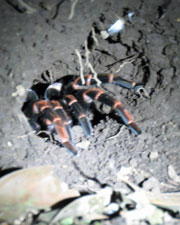 Tarantula guarding its burrow |
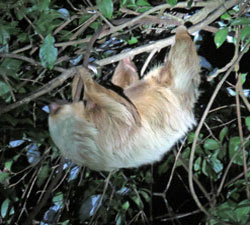 2-toed sloth on the move |
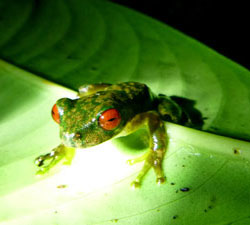 Red-eyed tree frog |
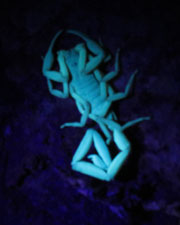 The luminescent scorpion |
|
|
The next day, some of us continued our exploration of the cloud forest by catching a taxi up to the Monteverde Forest Reserve and spending the morning wandering the well-formed paths beneath a dense and dripping canopy of tall, lichen and moss clad trees, their trunks covered with vines and epiphytes. |
||
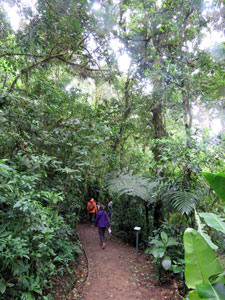 The rich green tapestry .... |
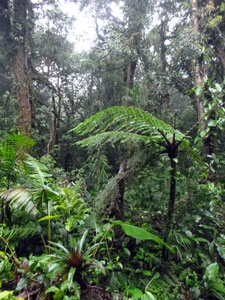 .... of the cloud forest ... |
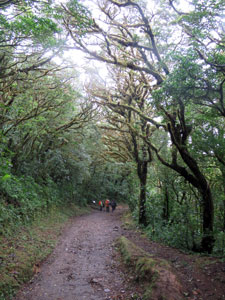 .... in Monteverde |
|
The species richness of the cloud forest is incredible and it was impossible not to be impressed by the overwhelming greenness of it. Curious though was the virtual absence of fungi. |
|||
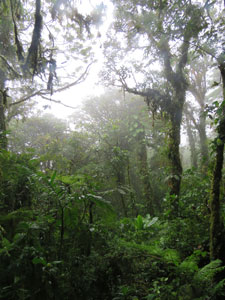 |
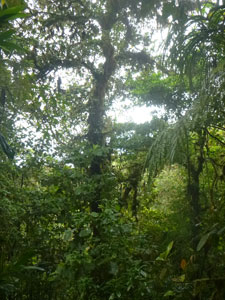 |
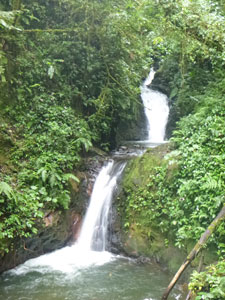 |
|
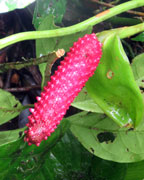 |
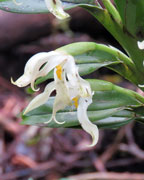 |
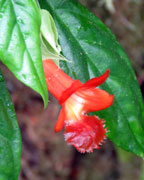 |
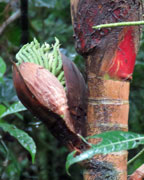 |
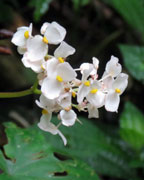 |
 |
Monteverde is well-known for its bird-life and the number of birdwatchers lining up to visit when we arrived, armed with giant camera lenses ad spotting scopes was boggling. However, take away the sound of the rushing wind in the canopy above, the forest was a silent place – just the occasional twitter of a bird. The bird-watchers would be working hard for their rewards. In fact, in the absence of much bird or mammalian life (though our sloth count rose to two), we took to spotting the rare flashes of colour of a forest flower in this world of endless green. It was an enjoyable few hours. |
|||||
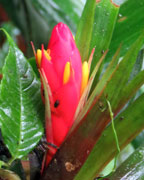 |
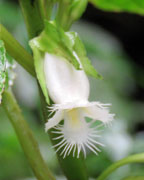 |
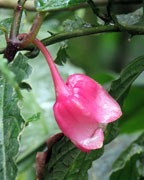 |
 |
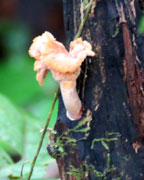 |
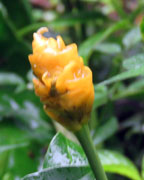 |
|
Emerging once again into civilisation, we opted for a coffee at the Café de Colibris, where you can sip your latte and enjoy the many species of hummingbird that are attracted to the café's feeding stations. The word "exquisite" must have been coined for hummingbirds. Finally, the fair Nello and I decided to walk back the 5 km from forest reserve to town – a last chance to breathe the fresh mountain air and enjoy this unique part of Costa Rica. |
|
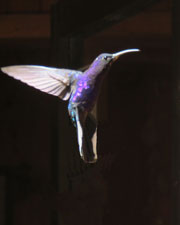 |
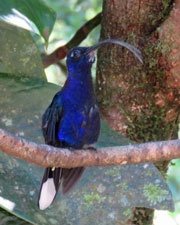 An assortment .... |
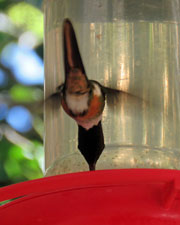 .... of hummingbirds .... |
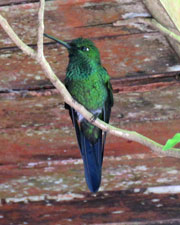 .... at Café de Colibris |
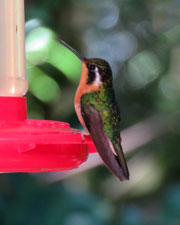 |
|
Arenal |
For the third night in a row, the wind howled and rattled the panes. We were not that unhappy to leave and head for a lower altitude and, with the thin wisps of the Caribbean side cloud bank sweeping overhead, we headed off for the drive over pot-holy gravel roads and along the landslip-prone steep cleared slopes of these highlands to reach the shores of Lago Arenal. |
|
|
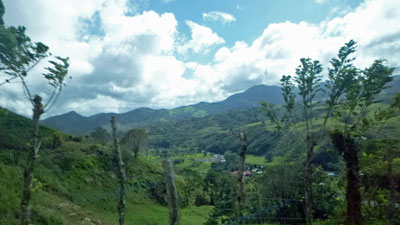 Rural landscape of the Costa Rican highlands |
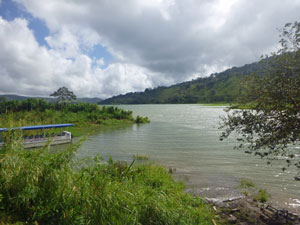 Pick-up point at Lago Arenal |
|
Here, in a small reedy cove, we clambered aboard an open 24-seater boat for the trip up the choppy surface of this long body of water held back by a dam built in 1972. It was a pleasant trip, with the dark shape of distant cloud forest-covered mountains backing the dense green vine-clad vegetation of the shore. At the far end, the cloud-topped shape of Volcan Arenal grew larger and larger. Nearing the dam, our boat pulled into another cove and we all got out to clamber aboard a mini "chicken bus" for the short ride around the northern slopes of the volcano to La Fortuna, our destination for the next two nights. |
||
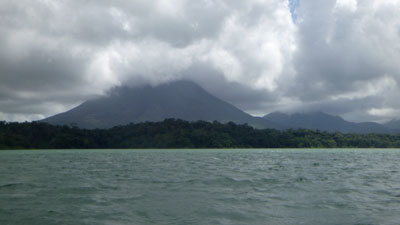 Cloud covered Volcan Arenal brooding over the grey lake waters |
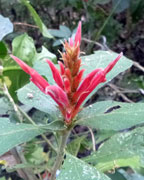 |
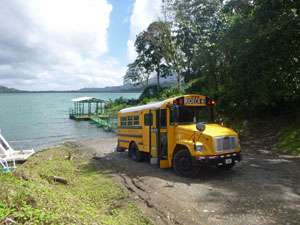 The chicken bus arrives to collect us |
|
Arenal is a tourist hot-spot of Costa Rica and La Fortuna is the hub. It is the most expensive town in the most expensive country of Central America, and was the most up-market town we had visited since Playa del Carmen in Mexico. Unfortunately, tourism has driven a market based on very expensive adventure-type activities and our group was feeling a bit jaded of such things.
|
So, after settling in, our guide Isaac led us all down to the local swimming hole on the Rio La Fortuna, where we could soak away the tiredness of travel in the fast-flowing clear water surrounded by rain forest - and as a bonus, a tiny emerald-green and white hummingbird took a bath less than a metre away in the river ….. hover, splash, hover, splash ……. for almost a minute – a trip highlight. |
|
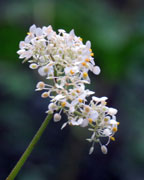 |
The next day was hot and sunny – perfect to revisit the cool waters of Rio Fortuna. The fair Nello wanted to catch up on correspondence, so I headed off solo on a 6km hike up to the Cataratas de la Fortuna, a 70m waterfall that plunged down into a jungle-clad chasm beneath the slopes of Cerro Chato, an old volcanic crater. Once at the entrance, the sign said 500 steps down to the base of the falls and the swimming hole, a clear sandy-bottomed pool some 30m downstream from the plunge pool of the fall. |
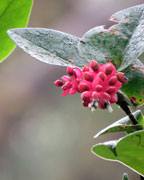 |
||
|
Here the waterfall thundered down to create a powerful mist of horizontal spray – a great place to cool off. On the climb out, I counted the steps …. 511. Some pleasures have to be earned. |
|
|
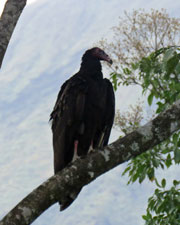 |
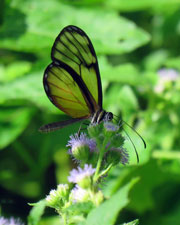 |
||
|
Our watery adventures in Arenal continued that evening. Being at the base of a volcano, La Fortuna boasts many hot-spring resorts and Clarity joined the fair Nello and I for an evening visit and dinner at Los Lagos Resort, which boasted seven hot-spring pools. Now, my experience of hot-springs comes from Japan, where the ambience is pure zen, with small pools and the chance to soak away the world's troubles in serenity and quiet. When we saw the first pool at Los Lagos, with its water-bar, water-slide, crowds of noisy kids and adults drinking in the pool, my heart sank a little. However, wondering higher up the slopes, we found our little bit of Costa Rican zen, the top had two small adjacent pools, one at 40°C and one at 25°C, great for successive bouts of hot soak and cold relief. |
|
For almost an hour we were alone, though the spell was broken when a big group of noisy gringos descended into the pool to take their selfies ….. it was time to go and have dinner, a pleasant way to finish our visit to the Arenal volcano region. |
|
Tortuguero National Park (distances) |
The last day of our tour dawned with grey skies and drizzle, though still pleasantly warm. It didn't really matter, as all that was left was a drive from La Fortuna to San José, the Costa Rican capital. Here, after a short wander about the main city area, we had our farewell dinner. |
|
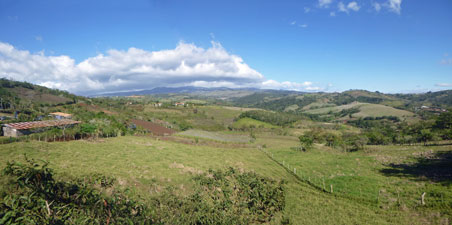 Rural landscape on the way to San José |
 Castillo Azul in San José |
Having finished or Intrepid touring adventure, the fair Nello, Mike, Odile and myself had a couple of days to fill before heading on to Cuba. So, we planned a short side-trip to Tortuguero National Park in the lowland rain forest of Costa Rica's Caribbean Coast. Thus, we found ourselves up at 6am ready to be picked up by mini-van for the trip there from San José. |
|
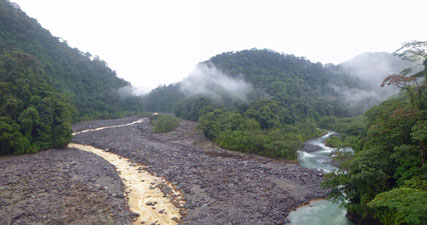 Los Rios Sucio y Hondura |
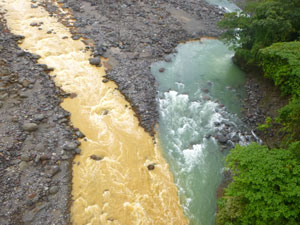 The meeting of the rivers |
The bus escaped from the city before the traffic picked up and headed eastwards and upwards to climb up over the central range. Once we had crested the hills, there was a long winding descent through the dense mist-shrouded vegetation of Braulio Carillo National Park. The cloud forest was demonstrating why it is so called. Near the bottom, we made a brief stop to view the convergence of the sulphur-stained volcanic waters of Rio Sucio and the clear mountain waters of Rio Hondura – a spectacular sight. |
|||
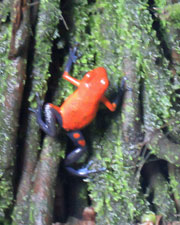 |
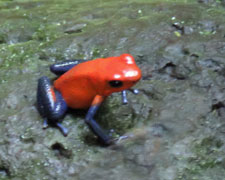 Poison arrow frogs (in very low light) |
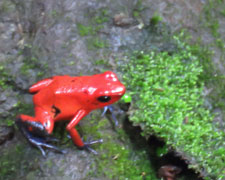 |
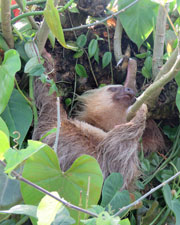 |
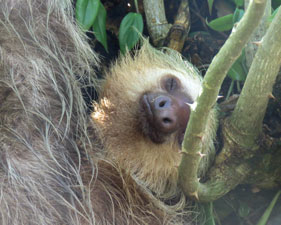 A sleeping 3-toed sloth |
By the time we reached the flatter Caribbean plain, we were out of the clouds and the sun shone hot and humid. The road turned north to pass through banana plantations and cattle country, punctuated by a couple of roadside stops to see some three-toed sloths and poison arrow frogs. The road turned to gravel and gradually deteriorated, till finally we reached La Pavona on the Rio Suerte. It was time to transfer to a boat for the zippy ride down the many jungle clad bends of this river. |
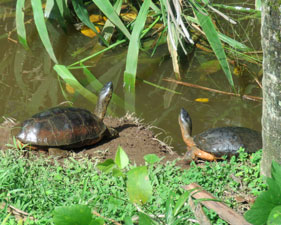 A pair of river tortoises |
|
|
|
On the way, our guide pulled in for closer looks at crocodiles, caiman, iguanas, basilisks and assorted water-birds. It was a pleasant trip into the village of Tortuguero. Here we pulled into the dock and disembarked, to be shown our basic but authentic "eco-lodge" accommodation on the shores of a very rough Caribbean Sea. |
||
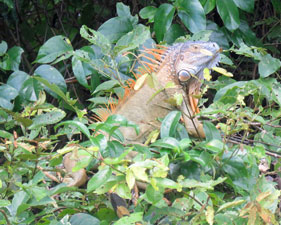 Riverside wildlife - iguana ...... |
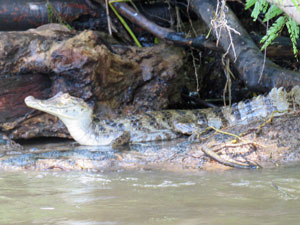 .... caiman .... |
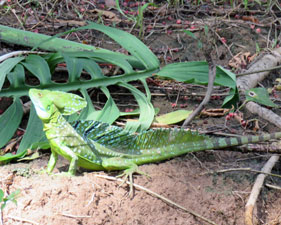 .... and basilisk lizard |
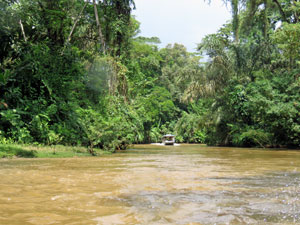 Heading towards Tortuguera Heading towards Tortuguera |
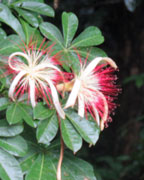 |
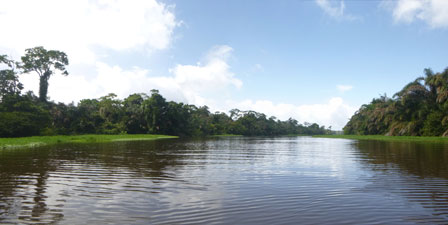 A large lagoon on Rio Suerte |
The afternoon was ours to get our bearings and enjoy this little town, for the next day was destined for exploration, by boat and then on foot, of the canals, rain-forest, flora and fauna of this isolated region that the locals call "the Amazon of Costa Rica". |
||
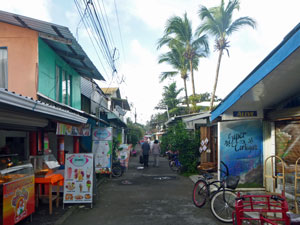 The streets of Tortuguero |
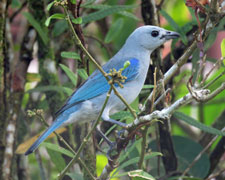 |
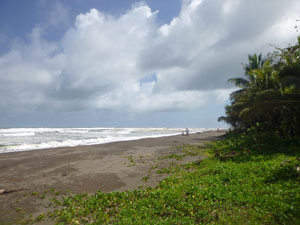 Big seas on the Caribbean coast |
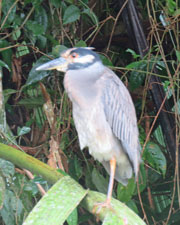 |
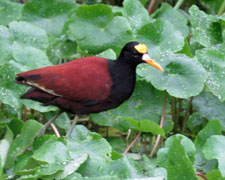 Birdlife of .... |
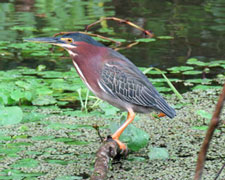 ... the lowland rain forest |
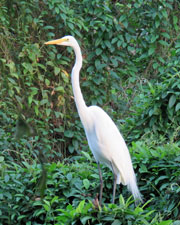 |
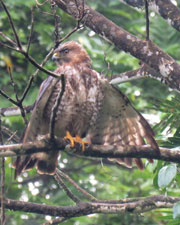 |
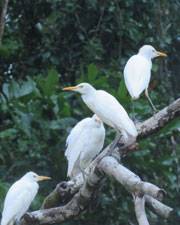 |
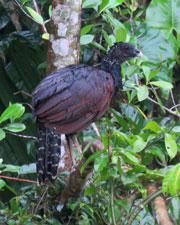 |
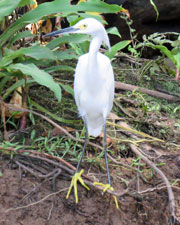 |
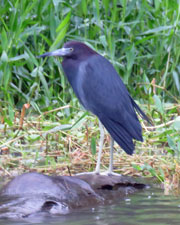 |
|
We were lucky with our boat trip up the Tortuguero waterways. Heavy rain squalls had rolled in all night long and were still around when we boarded the boat at 6am. I felt guilty getting into our boat with just 6 other people – it had a roof and all the boats about us were open to the rain and full. I couldn't look those people in the eye. We had a very good guide, Kevin, who spoke both Spanish and Jamaican-accented English (reflecting the heritage of this Caribbean Coast region) and an eagle-eyed boat driver, who helped spot a large array of wildlife, despite the passing showers. |
|
|||
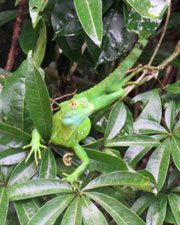 |
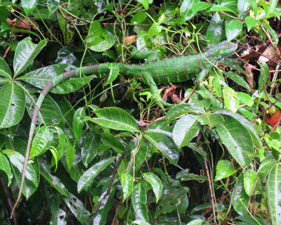 Reptiles of the..... |
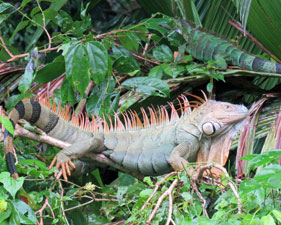 .... Tortuguero rain forest waterways |
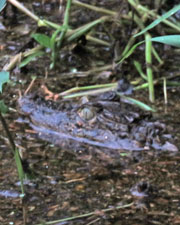 |
|
We were even luckier with our walk in the rain forest – the sun came out and with the fine weather, macaws and other parrots, howler and spider monkeys and an array of lizards and other creatures. Thanks, Kevin, for showing us Tortuguero.
|
|
The rain returned in the afternoon and a pattern of heavy squall followed by fine interlude set in for the rest of the day, night and into the following day. I actually enjoy watching a tropical downpour while under a deck roof with a hot coffee in hand, so it really didn't matter that much. It was a good time to catch up on some correspondence. |
||
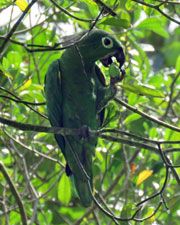 |
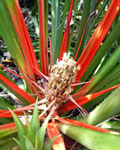 |
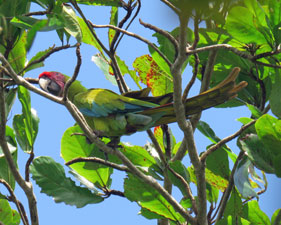 The green macaw |
 |
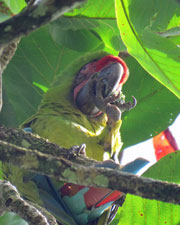 |
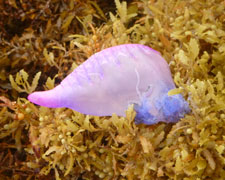 |
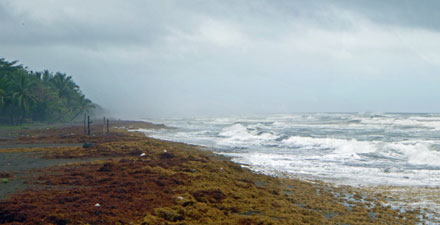 Stormy day on the Caribbean coast |
 |
Then it was time to dodge the rain squalls and get back to the boat for the return trip up the Rio Suerte, now swollen with the rain – fast-flowing, carrying lots of debris and bursting its banks in places. It was an interesting ride. From there another long bus trip brought us back up through the mist-shrouded cloud forest mountains and back to San José. |
||
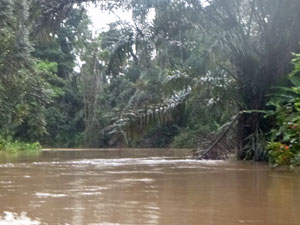 Heading home up the Rio Suerte |
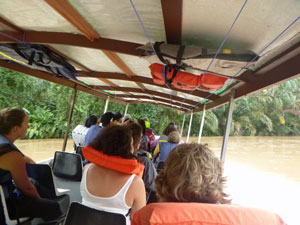 Taking a corner at speed |
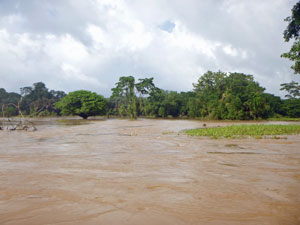 Floodwaters at La Pavona |
One more night and an early rise to get to the airport – our Central America trip was over, as we left Costa Rica and headed to Cuba. As the Costa Ricans say ….. Pura vida!
|
||
|

